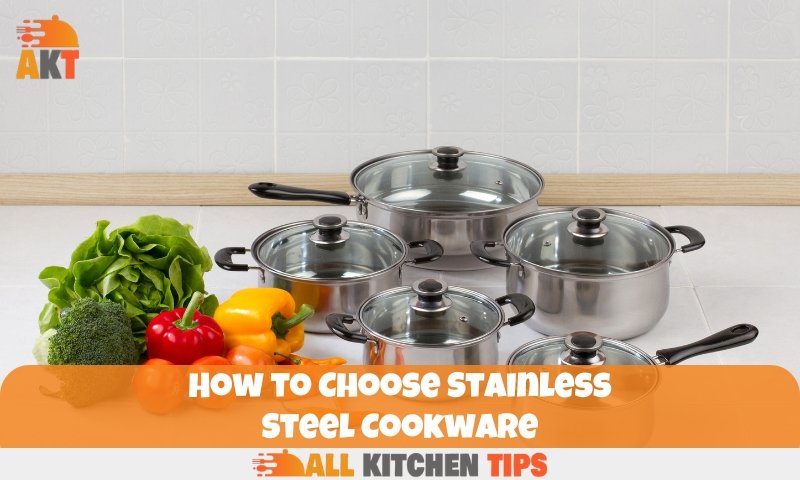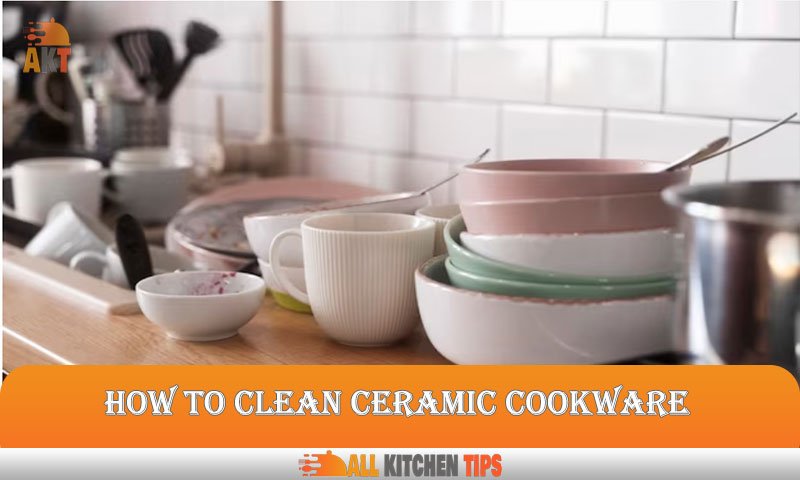When choosing stainless steel cookware, look for high-quality materials and construction. When selecting cookware, consider the types of cooking you’ll be doing and your budget.
Stainless steel cookware with a copper or aluminum base is an excellent option, as these materials provide even heat distribution. Cooking with stainless steel cookware can be an excellent choice because it is durable, non-toxic, and non-reactive. Additionally, it is easy to clean, and it looks great in any kitchen.
However, selecting the right stainless steel cookware can be a daunting task. There are many options available on the market, which can make it difficult to determine what is right for you. In this article, we will discuss the essential factors you should consider when selecting stainless steel cookware to help you make an informed decision. We will cover everything from materials to size to help you find the perfect cookware for your cooking needs and budget.
Benefits Of Stainless Steel Cookware

Why Stainless Steel Is A Popular Choice For Cookware
Stainless steel is a popular material for cookware and for good reason. It is a durable and sturdy metal that is resistant to rust and corrosion. It is used not only in cookware but also in kitchen appliances, sinks, countertops, and even medical equipment.
Advantages Of Using Stainless Steel Over Other Materials
Stainless steel cookware offers many benefits over other materials. Here are some of the key advantages:
- Durability: Stainless steel cookware is highly durable and can last for many years, even with regular use.
- Easy to clean: Stainless steel is non-porous, making it easy to clean. It does not absorb any food flavors or odors, and it is dishwasher-safe.
- Non-reactive: Stainless steel is non-reactive with different foods, making it a great material for cooking acidic dishes like tomato sauce.
- Safe: Stainless steel is a safe material to use in cookware. It does not release any harmful chemicals or toxins, even at high temperatures.
- Versatile: Stainless steel cookware can be used on a variety of stovetops, including electric, gas, and induction cooktops.
- Stylish: Stainless steel cookware looks great in any kitchen. It has a sleek and modern appearance that can complement any kitchen décor.
When it comes to choosing cookware, stainless steel is a popular choice for many people. It is a durable, easy-to-clean, non-reactive, and safe material that can last for many years. With its versatile and stylish appearance, stainless steel cookware is a great investment for any home cook.
Important Factors To Consider When Choosing Stainless Steel Cookware
Material Composition And Quality
Stainless steel cookware is made of a combination of metals, including iron, chromium, nickel, and sometimes other metals that provide strength, resistance to corrosion, and durability. When choosing stainless steel cookware, consider the material’s composition and quality. Here are some factors to keep in mind:
- Grade of stainless steel: Look for cookware made with 18/10 stainless steel, indicating that it contains 18% chromium and 10% nickel. This grade of stainless steel is more resistant to corrosion and rust than lower grades.
- Cladding: Cookware with a layered design improves heat distribution and prevents hot spots. Look for cookware that has a thick core of copper or aluminum encapsulated between layers of stainless steel.
- Gauge: The thickness of stainless steel cookware is measured in gauge. The lower the gauge, the thicker and more durable the cookware. Aim for cookware with a gauge of at least 18-10.
Construction And Design Of The Cookware
The construction and design of stainless steel cookware are another important factor to consider. Look for cookware with sturdy construction, durable handles and knobs, and tight-fitting lids. Here are some additional features to keep in mind:
- Riveted handles: Cookware with riveted handles is more secure and durable than those that are welded or screwed on.
- Rolled rims: Cookware with rolled rims prevents drips and spills while pouring liquids.
- Dishwasher-safe parts: Cookware with dishwasher-safe parts can save time and hassle when cleaning.
Compatibility With Different Types Of Stovetops
Before purchasing stainless steel cookware, it’s important to ensure it’s compatible with your stovetop. Keep in mind the following:
- Gas stovetops: Stainless steel cookware is compatible with gas stovetops and provides even cooking.
- Electric stovetops: Stainless steel is also compatible with electric stovetops but can take longer to heat up.
- Induction stovetops: Not all stainless steel cookware works with induction stovetops, so look for cookware labeled as compatible with induction.
Non-Stick Coatings vs Uncoated Stainless Steel
Stainless steel cookware is available with or without a non-stick coating. Consider the pros and cons of both when making a decision:
- Non-stick coatings: Cookware with non-stick coatings prevents food from sticking to the pan and makes cleaning easier. However, these coatings can wear off over time and are generally not recommended for high-heat cooking.
- Uncoated stainless steel: Cookware without a non-stick coating allows for more flexibility in cooking and can be used at high heat. However, food may stick to the pan, making cleaning more difficult.
Durability And Maintenance
Stainless steel cookware is known for its durability and requires minimal maintenance. However, to ensure your cookware lasts a long time, keep the following in mind:
- Avoid abrupt temperature changes: Rapid changes in temperature can cause warping or damage to the cookware. Allow the cookware to cool before placing it in water or a refrigerator.
- Clean properly: Stainless steel cookware is easy to clean. Avoid using abrasive sponges or harsh cleaning agents that can cause scratches and wear over time.
- Storage: To avoid scratches, stack pans with a layer of lining or towel between them. Store pans appropriately in a cool and dry place.
Understanding Stainless Steel Grades

Stainless steel is an alloy composed of iron, carbon, and chromium. The percentage of chromium in the stainless steel determines the specific grade. Some common stainless steel grades for cookware are 18/10, 18/8, and 18/0. Here’s what these numbers mean:
- 18 refers to the percentage of chromium in the stainless steel. In this case, it is 18%.
- The second number is the amount of nickel in the steel, ranging from 0-10%, and is an indicator of rust resistance.
- The fraction represents the percentage of manganese.
How To Determine The Quality Of Stainless Steel Cookware Based On Grades
When choosing stainless steel cookware, the grade should be a crucial factor in your decision. Here are some factors to consider when evaluating the quality of stainless steel cookware:
- Nickel content: The higher the nickel content, the more resistant it is to rust and corrosion.
- Thickness: A thicker pan will distribute heat more evenly and be less likely to warp.
- Cladding: Choose pans that offer three-ply or multi-clad. The interior and exterior layers of the pan should be made of 18/10 stainless steel, while the core is made of either aluminum or copper.
- Surface: Look for a polished surface that resists scratches and stains.
The Impact Of Grades On Cooking Performance And Safety
The grade of stainless steel directly affects its cooking performance and safety. Here are the possible impacts of various grades of stainless steel cookware on cooking performance and safety:
- 18/10: The most common grade of stainless steel used in high-end cookware because of its rust-resistant and non-reactive qualities. It is safe to use and does not leach into food.
- 18/8: A less expensive grade than 18/10, it still offers good performance and is safe to use.
- 18/0: This grade is magnetic, less expensive than 18/10, and less resistant to rust. It may interact with acidic foods or leach nickel, which can trigger allergic reactions in some people.
Stainless steel cookware’s grade impacts its quality, durability, and safety. Choosing cookware with higher grades of stainless steel, like 18/10 and 18/8, can ensure better performance and safety. However, it costs more. Therefore, it would be best to understand the impacts of different grades to make an informed decision while purchasing stainless steel cookware.
Cookware Sizes And Styles
Understanding The Different Sizes And Types Of Stainless Steel Cookware
When it comes to stainless steel cookware, there are various sizes and types to choose from, each suitable for different cooking tasks. Here are some key points to help you understand:
- Sizes: Stainless steel cookware size options usually range from small to large. The most common sizes are 8, 10, and 12 inches in diameter.
- Types: Common types of stainless steel cookware include stockpots, saucepans, sauté pans, frying pans, and Dutch ovens.
Pros And Cons Of Different Styles, Such As Stockpots, Saucepans, And Sauté Pans
Every type of stainless steel cookware has its pros and cons, some of which are:
- Stockpots: Pros- ideal for making soups, stews, and chili. Its large size allows for large batches of food. Cons- not suitable for cooking small portions.
- Saucepan: Pros- versatile cookware suitable for almost all kinds of cooking styles. Its size is perfect for making sauces, gravy, rice, and pasta. Cons- not suitable for cooking large portions of, for example, big cuts of meat.
- Sauté pan: Pros- perfect for searing, browning, and sautéing small to medium-large portions of food. Cons- not suitable for cooking larger portions of food.
Which Sizes And Styles Are Best For Different Types Of cooking?
To choose the right size and style of cookware, you need to consider the type of food you’re preparing, the cooking method, and the portion size. Here are some tips:
- Stockpots: Large batches of soup, stew, or chili require a stockpot with a capacity of at least 12 quarts or more.
- Saucepan: Typically, 2-4 quart size saucepans are perfect for cooking rice, sauces, and pasta.
- Sauté pan: Small sauté pans with 8-10 inch diameters are ideal for medium-large steaks, fish fillets, and small portions of vegetables.
By considering the different sizes, types, and suitable pieces of cookware available, you will be better able to choose the best option for your cooking needs.
FAQs
Is Stainless Steel Cookware Safe For your Health?
Stainless steel cookware is safe for health as it does not react with acidic or basic foods. It is a non-toxic metal and does not release harmful toxins or chemicals during cooking.
Why Choose Stainless Steel Cookware?
Stainless steel cookware is durable, long-lasting, and easy to clean. It is a good conductor of heat and does not react with food, making it a safe choice for cooking. Unlike non-stick, it can withstand high temperatures.
How To Care For Stainless Steel Cookware
Clean stainless steel cookware with warm, soapy water and a sponge. Use a non-abrasive cleaner for tough stains. Avoid using metal utensils to prevent scratches. Dry thoroughly to prevent water spots.
Conclusion
As you can see, choosing high-quality stainless steel cookware can make a real difference in your cooking experience. With the right material, you can enjoy evenly cooked meals that are cooked to perfection. Remember, stainless steel cookware is not only durable but also easy to clean and maintain.
Be sure to pay attention to the construction, grade, design, and price when making a purchase. Every cookware set comes with unique features and benefits that will meet your specific cooking needs. Make your cooking experience even more enjoyable with the right stainless steel cookware set.
Don’t forget to protect your investment by following the care instructions for your cookware. Happy cooking!





